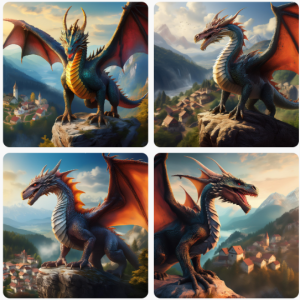
This post was created as a support resource for participants of the image generation pilot. It may also be helpful to anyone who’s interested in the applications of generative AI and image generation in education.
Getting started
If you decide to use Adobe Firefly at your oranisation, follow the steps set out below:
- Go to https://www.adobe.com/uk/products/firefly.html
- Click the ‘Sign in’ button at the top right-hand corner of the screen. If you already have an account, you can sign in straight away. You can also sign in using Google, Facebook, Apple, Microsoft and Line. If you don’t have an account, you will need to create one by entering your email address and setting up a password.
- When you’re logged in, click on ‘Creativity & Design’ in the top banner and select ‘Adobe Firefly’ from the menu. This is on the right-hand side of the drop-down menu.
- You’ll then have the option to access the different generative AI features that are powered by Firefly models and services. We’ll be focusing on ‘Text to Image’ in this blog, but the other options are briefly mentioned later. You don’t need to buy or sign up for a free trial to use this feature. To get started, click on ‘Create with Firefly’.
Examples of use
Here’s my experience of using Firefly. I began by typing in my prompt, keeping it relatively simple.
“A dragon standing on the edge of a cliff. In the background there is a village and mountains.”
I then clicked the ‘Generate’ button and these are the images it generated. 
I thought they were fantastic starting points, but they weren’t quite what I wanted.
So the next step was to revisit my prompt. If you make sure the ‘Suggestions’ option is toggled on when you click to start typing, various recommendations pop up for you to choose from. Depending on what you want to create, some of these may be spot on already. For me, they provided some inspiration.
My prompt then became:
“A dragon standing on the edge of a cliff. In the background there is a village and mountains. Fairytale and fantasy style.”
I wanted to enrich my design, so if you look at the options to the left of the images, you’ll find the built-in tools and special effects that you can use to modify your image. This, I think, is where Firefly really shines.
These options make it easier to customise your image and achieve the desired outcome, allowing your vision to adapt and evolve as you go. This really helped with my creativity when I was trying out the tool as I hadn’t considered all the additional elements.
The options you can choose from include:
- Content type (Art or Photo)
- Composition (you can add a reference photo, either by browsing the gallery or uploading an image)
- Styles (you can use the slider to increase or reduce the ‘visual intensity’ and again upload/choose from reference images).
- Effects (Popular; Movements; Themes; Techniques; Effects; Materials; Concepts)
- Colour and tone
- Lighting
- Camera angle
I chose:
Effects: ‘Fantasy’ from ‘Movements’ , and ‘Digital Art’ from ‘Themes’
Colour and tone: Pastel Colour
Lighting: Surreal lighting
Camera angle: Shallow depth of field
I also added some text to my prompt so my prompt was now:
“A dragon standing on the edge of a cliff. In the background there is a village and mountains. The village has lights on as the sun is beginning to set. Fairytale and fantasy style.”
I clicked ‘Generate’ again. This time, it took a little while longer to generate (maybe 20 – 25 seconds), which may be because I added the detail around the time of day (“the sun is beginning to set”).
I was really happy with the outcome and downloaded the images easily by clicking the ‘Download all’ button at top right of screen.




In an educational context, I think these images could serve as prompts for creative writing. They could help students better imagine their scenes and characters, resulting in more immersive stories. I also think they would be great within a design course. When I studied Textiles in school, this would have been incredibly useful for visualising colour palettes and project ideas. Overall, I found the process valuable for sparking creativity and finding inspiration.
Pricing
It is free to use, and users have a monthly allowance of 25 credits. For context, I used about 3 credits to create my example.
If you’d like, there is also an option to upgrade for a price. More information can be found on their website.
Further Features
If you already have Adobe suite then you can use the following. Alternatively, you can sign up for a free trial if you’d like to give them a try.
- Generative Fill: This is now in the Adobe Photoshop (beta) app and allows users to ‘create richer more lifelike images with more control than ever before’. This is available to buy or access as a free trial. There is a wealth of information on their website so if this is something you want to use, you should be able to find answers to your questions here.
- Generate Video: This allows you to ‘turn your text or image into video’, and ‘explore new ideas quickly, fill gaps in your timeline, and add new elements to existing footage’. Although not available just yet, there is a waitlist you can join. You can also read more about the Firefly Video Model on their website.
- Generative Remove: This is available in Adobe Lightroom and lets users ‘remove distractions from the background’. This is also available to buy or to access as a free trial and more information can be found on their website.
Key considerations
When using generative AI for image creation, it’s important to be aware of ethical issues. With regards to the environment, you can read more in our blog post, Artificial intelligence and the environment: Taking a responsible approach. We would always recommend only using image generation tools to create images that do not already exist to minimise any unnecessary environmental impact. Always check a search engine in the first instance.
Adobe advises that “the current Firefly generative AI models were trained on a dataset of licensed content, such as Adobe Stock, and public domain content where copyright has expired. To ensure that creators can benefit from generative AI, we’ve developed a compensation model for Adobe Stock contributors whose content is used in the dataset to retrain Firefly models.”
General concerns around image generation include copyright/IP issues, hallucinations, and perpetuations of bias. Our blog on the topic of image generation is a great starting point to understanding these limitations.
Find out more by visiting our Artificial Intelligence page to view publications and resources, join us for events and discover what AI has to offer through our range of interactive online demos.
For regular updates from the team sign up to our mailing list.
Get in touch with the team directly at AI@jisc.ac.uk
